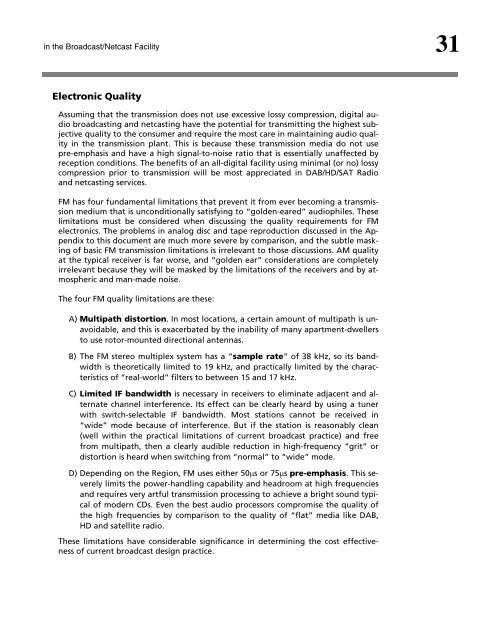Maintaining Audio Quality in the Broadcast Facility 2011 - Orban
Maintaining Audio Quality in the Broadcast Facility 2011 - Orban
Maintaining Audio Quality in the Broadcast Facility 2011 - Orban
You also want an ePaper? Increase the reach of your titles
YUMPU automatically turns print PDFs into web optimized ePapers that Google loves.
<strong>in</strong> <strong>the</strong> <strong>Broadcast</strong>/Netcast <strong>Facility</strong> 31<br />
Electronic <strong>Quality</strong><br />
Assum<strong>in</strong>g that <strong>the</strong> transmission does not use excessive lossy compression, digital audio<br />
broadcast<strong>in</strong>g and netcast<strong>in</strong>g have <strong>the</strong> potential for transmitt<strong>in</strong>g <strong>the</strong> highest subjective<br />
quality to <strong>the</strong> consumer and require <strong>the</strong> most care <strong>in</strong> ma<strong>in</strong>ta<strong>in</strong><strong>in</strong>g audio quality<br />
<strong>in</strong> <strong>the</strong> transmission plant. This is because <strong>the</strong>se transmission media do not use<br />
pre-emphasis and have a high signal-to-noise ratio that is essentially unaffected by<br />
reception conditions. The benefits of an all-digital facility us<strong>in</strong>g m<strong>in</strong>imal (or no) lossy<br />
compression prior to transmission will be most appreciated <strong>in</strong> DAB/HD/SAT Radio<br />
and netcast<strong>in</strong>g services.<br />
FM has four fundamental limitations that prevent it from ever becom<strong>in</strong>g a transmission<br />
medium that is unconditionally satisfy<strong>in</strong>g to “golden-eared” audiophiles. These<br />
limitations must be considered when discuss<strong>in</strong>g <strong>the</strong> quality requirements for FM<br />
electronics. The problems <strong>in</strong> analog disc and tape reproduction discussed <strong>in</strong> <strong>the</strong> Appendix<br />
to this document are much more severe by comparison, and <strong>the</strong> subtle mask<strong>in</strong>g<br />
of basic FM transmission limitations is irrelevant to those discussions. AM quality<br />
at <strong>the</strong> typical receiver is far worse, and “golden ear” considerations are completely<br />
irrelevant because <strong>the</strong>y will be masked by <strong>the</strong> limitations of <strong>the</strong> receivers and by atmospheric<br />
and man-made noise.<br />
The four FM quality limitations are <strong>the</strong>se:<br />
A) Multipath distortion. In most locations, a certa<strong>in</strong> amount of multipath is unavoidable,<br />
and this is exacerbated by <strong>the</strong> <strong>in</strong>ability of many apartment-dwellers<br />
to use rotor-mounted directional antennas.<br />
B) The FM stereo multiplex system has a “sample rate” of 38 kHz, so its bandwidth<br />
is <strong>the</strong>oretically limited to 19 kHz, and practically limited by <strong>the</strong> characteristics<br />
of “real-world” filters to between 15 and 17 kHz.<br />
C) Limited IF bandwidth is necessary <strong>in</strong> receivers to elim<strong>in</strong>ate adjacent and alternate<br />
channel <strong>in</strong>terference. Its effect can be clearly heard by us<strong>in</strong>g a tuner<br />
with switch-selectable IF bandwidth. Most stations cannot be received <strong>in</strong><br />
“wide” mode because of <strong>in</strong>terference. But if <strong>the</strong> station is reasonably clean<br />
(well with<strong>in</strong> <strong>the</strong> practical limitations of current broadcast practice) and free<br />
from multipath, <strong>the</strong>n a clearly audible reduction <strong>in</strong> high-frequency “grit” or<br />
distortion is heard when switch<strong>in</strong>g from “normal” to “wide” mode.<br />
D) Depend<strong>in</strong>g on <strong>the</strong> Region, FM uses ei<strong>the</strong>r 50�s or 75�s pre-emphasis. This severely<br />
limits <strong>the</strong> power-handl<strong>in</strong>g capability and headroom at high frequencies<br />
and requires very artful transmission process<strong>in</strong>g to achieve a bright sound typical<br />
of modern CDs. Even <strong>the</strong> best audio processors compromise <strong>the</strong> quality of<br />
<strong>the</strong> high frequencies by comparison to <strong>the</strong> quality of “flat” media like DAB,<br />
HD and satellite radio.<br />
These limitations have considerable significance <strong>in</strong> determ<strong>in</strong><strong>in</strong>g <strong>the</strong> cost effectiveness<br />
of current broadcast design practice.



![[PDF] Using the ITU BS.1770-2 and CBS Loudness Meters ... - Orban](https://img.yumpu.com/50629372/1/190x245/pdf-using-the-itu-bs1770-2-and-cbs-loudness-meters-orban.jpg?quality=85)






![[PDF] Optimod-FM Feature Comparison - Orban](https://img.yumpu.com/41741615/1/190x245/pdf-optimod-fm-feature-comparison-orban.jpg?quality=85)






